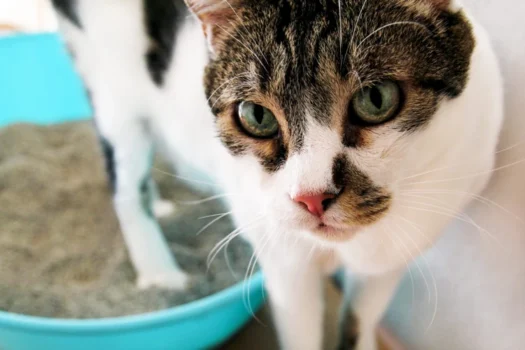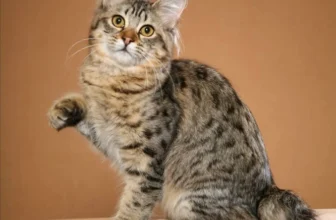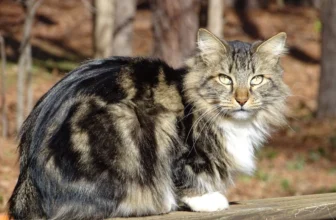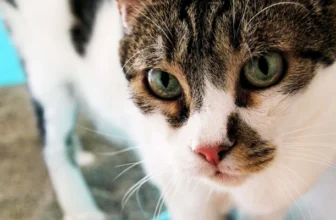When it comes to our furry friends, we want to ensure they are healthy and happy. However, just like humans, cats can experience health issues, such as urinary tract infections (UTIs). If you’re a proud owner of an American Bobtail cat, it’s crucial to understand the causes, symptoms, and treatment options for this condition. This article will provide you with all the necessary information to identify and treat a UTI in your American Bobtail cat, as well as tips for preventing it from occurring. So, let’s dive into the world of UTIs in cats and learn how to keep our feline friends healthy and comfortable!
Causes of Urinary Tract Infections in American Bobtail Cats
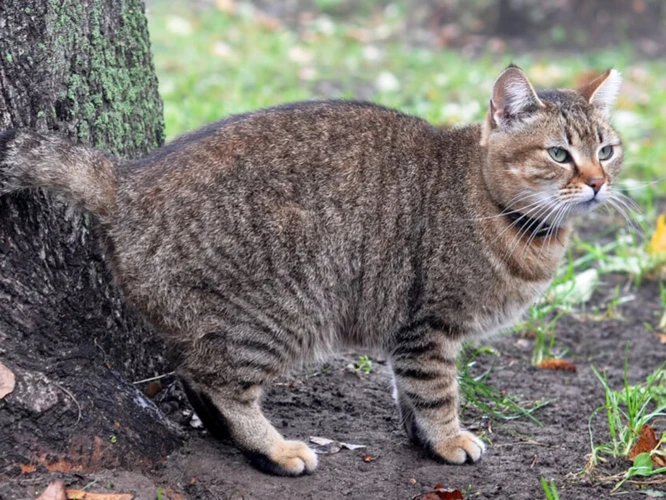
Urinary Tract Infections (UTIs) are a common occurrence in American Bobtail Cats, causing discomfort and pain. However, UTIs are preventable and treatable. Understanding the causes is crucial in helping your furry friend stay healthy. There are various causes of UTIs in American Bobtail Cats, including age and gender, urinary obstruction, bladder stones, and weakened immune system. Knowing the causes will help you take appropriate measures to prevent UTIs in your cat. Let’s take a closer look at each cause and how it may lead to UTIs in American Bobtail Cats. To learn more about UTIs in Bobtail Cats, check out this article.
Age and Gender
Urinary tract infections (UTIs) are a common issue in American Bobtail cats, and age and gender are important factors that can increase the risk of developing UTIs. Elderly Bobtail cats are particularly susceptible to UTIs due to the weakening of their immune system, making it easier for bacteria to thrive in their bladder or urinary tract.
Male Bobtail cats are also at a higher risk of developing UTIs compared to females because their urethras are narrower and longer, which can make it more difficult for them to fully empty their bladder, leading to stagnant urine that provides an ideal environment for bacteria growth. Male Bobtail cats who have not been neutered are even more prone to UTIs because the hormone testosterone can increase the thickness of their bladder wall, making it harder to fully empty their bladder.
Female Bobtail cats, on the other hand, have a wider and shorter urethra, which makes it easier for them to flush bacteria out of their system. However, female Bobtail cats who have been spayed are at an increased risk of UTIs due to hormonal changes that can thicken their bladder wall and make it harder to fully empty their bladder.
Regardless of age or gender, Bobtail cats with UTIs may experience symptoms such as painful urination, frequent urination, blood in urine, and urinating outside the litter box. If your Bobtail cat is displaying any of these symptoms, it’s important to bring them to the vet for proper diagnosis and treatment, which may include antibiotics, pain relief medication, and fluid therapy. In severe cases, surgical intervention may be necessary to clear any blockages in the urinary tract.
To learn more about UTIs in American Bobtail cats, read our article on UTIs in Bobtail Cats, and for information on how UTIs are diagnosed and treated, read our article on Diagnosis and Treatment of UTI in American Bobtail Cats. To prevent UTIs in your Bobtail cat, make sure to keep them hydrated, maintain a clean litter box, schedule regular vet check-ups, and consider using urinary acidifiers.
Urinary Obstruction
Urinary obstruction is one of the leading causes of urinary tract infections (UTIs) in American Bobtail cats. This condition occurs when there is a blockage in the urethra, which is the narrow tube that carries urine from the bladder to the outside of the body. The blockage can be caused by various factors, such as the accumulation of pus or debris, crystals, stones, or a tumor.
If left untreated, urinary obstruction can lead to serious health complications, such as kidney damage or even death. It’s essential to recognize the signs of urinary obstruction in cats and seek prompt treatment from a veterinarian.
Common symptoms of urinary obstruction include:
- Difficulty urinating or complete inability to urinate
- Frequent attempts to urinate, but producing only small amounts or no urine at all
- Pain or discomfort when trying to urinate
- Licking around the genital area
- Abdominal discomfort or enlargement
- Vomiting or lethargy
Male cats are more prone to urinary obstruction due to their narrow urethra. Overweight and senior American Bobtail cats are at a higher risk of urinary obstruction.
If your cat is diagnosed with urinary obstruction, the veterinarian may perform a procedure called catheterization, where a tube is inserted into the urethra to remove the blockage. In severe cases where catheterization is ineffective, surgery may be necessary.
To prevent urinary obstruction, ensure that your American Bobtail cat is well-hydrated by providing fresh water regularly. You can also provide wet food, as it contains high moisture content that can keep your cat hydrated. Regular litter box maintenance is also crucial in preventing urinary obstruction. If your cat has been diagnosed with urinary obstruction, follow the veterinarian’s recommendations for proper diet and medication to prevent recurrence.
For more information on preventing UTIs in American Bobtail cats, check out our article on prevention of UTI in American Bobtail cats.
Bladder Stones
Bladder stones, also known as uroliths, are another common cause of urinary tract infections in American Bobtail cats. These stones are made up of minerals that clump together in the bladder, causing blockages and irritation. The most common minerals found in bladder stones include calcium, struvite, and oxalate.
Causes of Bladder Stones in American Bobtail Cats
Bladder stones can form due to a variety of factors including:
- High mineral content in the diet
- Dehydration
- Urinary tract infections
- Abnormal urine pH levels
- Genetic predisposition
If your American Bobtail cat is predisposed to forming bladder stones, it’s important to monitor their diet and make sure they are drinking enough water.
Symptoms of Bladder Stones in American Bobtail Cats
Similar to other urinary tract infections, the symptoms of bladder stones in American Bobtail cats can include:
- Painful urination
- Frequent urination
- Blood in urine
- Urinating outside the litter box
- Foul-smelling urine
However, in some cases, there may be no noticeable symptoms until the stones have become large enough to cause a blockage, which can be life-threatening.
Treatment of Bladder Stones in American Bobtail Cats
Treatment for bladder stones in American Bobtail cats depends on the size and location of the stones. In some cases, the stones may be small enough to be dissolved with a special diet. However, larger stones may require surgical removal. Your veterinarian may also recommend a change in diet and increased water intake to prevent future stone formation.
Bladder stones are a serious condition that can cause a great deal of discomfort for your American Bobtail cat. If you suspect your cat may have bladder stones, it’s important to seek veterinary attention immediately to prevent further complications.
Weakened Immune System
When a cat’s immune system is weakened, it can make them more susceptible to urinary tract infections (UTIs). There are several factors that can contribute to a weakened immune system in American Bobtail cats.
Causes of Weakened Immune System in American Bobtail Cats:
| Poor nutrition | Feeding your cat a diet that lacks essential nutrients can lead to a weakened immune system. It’s important to choose a high-quality, well-balanced diet for your cat. |
| Virus or bacterial infection | An existing illness, such as feline immunodeficiency virus (FIV) or feline leukemia virus (FeLV) can damage your cat’s immune system, leaving them more susceptible to UTIs. |
| Stress | Stress can suppress a cat’s immune system, making them more vulnerable to infections. |
| Age | Elderly cats may have a weaker immune system, leaving them more vulnerable to infections. |
If your American Bobtail cat has a weakened immune system, it’s important to take extra measures to prevent UTIs. This can include providing them with a high-quality diet, minimizing stress, and ensuring they receive regular veterinary check-ups. In some cases, your vet may also recommend supplements or medications to support their immune system. It’s important to work closely with your vet to address any underlying health issues that may be contributing to a weakened immune system and to ensure your cat stays healthy and happy.
Symptoms of Urinary Tract Infections in American Bobtail Cats
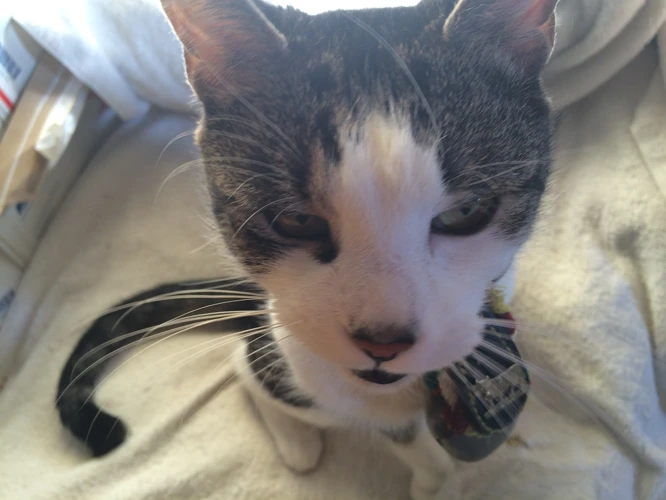
As a cat owner, it’s important to pay attention to your American Bobtail’s urinary habits. Urinary tract infections (UTIs) are a common health issue that can cause discomfort and even lead to serious complications if left untreated. It’s necessary to recognize the symptoms of UTIs in American Bobtail cats. In this section, we will explore the telltale signs of a UTI, from painful urination to lethargy and vomiting. Understanding these symptoms can help you identify and treat UTIs in your furry friend before they escalate.
Painful Urination
One of the most common symptoms of urinary tract infections in American Bobtail cats is experiencing painful urination. This can happen due to inflammation and irritation in the urinary tract caused by the bacteria present in the urine. Here are some signs that can indicate that your American Bobtail cat may be experiencing painful urination:
- Straining while urinating
- Crying out while urinating
- Attempting to urinate multiple times but producing only a small amount of urine
- Showing discomfort or reluctance when using the litter box
- Licking at genital area
If you observe any of these symptoms in your American Bobtail cat, it may be an indication of painful urination. In some cases, it could also be a sign of a more serious underlying health condition, so it’s best to seek the advice of a veterinarian promptly.
Urinary tract infections left untreated can lead to more severe issues, including kidney infections, so it’s important to take note of any unusual behavior in your feline friend. Seeking medical attention quickly can help to resolve the issue and ensure your cat stays healthy and comfortable.
Blood in Urine
One of the most concerning symptoms of urinary tract infections in American Bobtail cats is the presence of blood in their urine. This condition, known as hematuria, can be a sign of a serious infection or other underlying health issues. Here are some important details about blood in cat’s urine:
1. Causes: Hematuria can indicate a number of conditions, including urinary tract infections, bladder infections or inflammation, bladder stones, tumors, and even trauma to the urinary tract. It is important to determine the underlying cause, as some conditions can be more serious than others.
2. Appearance: Blood in a cat’s urine can vary in appearance from reddish-pink to brown or even orange. The color and consistency of the blood can offer clues as to the underlying cause of the condition.
3. Diagnostic tests: To determine the cause of hematuria, your veterinarian will likely perform a urinalysis, which may include a urine culture to identify any bacterial infections. Additional tests may be required, such as blood work, X-rays or ultrasound.
4. Treatment: Treatment for hematuria will depend on the underlying cause. In cases where a urinary tract infection is the cause, antibiotics are typically prescribed. Other treatments may include pain relief, fluid therapy or even surgical intervention for more serious conditions like bladder stones or tumors.
5. Prevention: Preventing hematuria in your American Bobtail cat involves proper nutrition, hydration, and regular veterinary check-ups. Always provide clean and fresh water for your cat, and try to avoid feeding them a diet that is high in magnesium or phosphorus, which can contribute to urinary tract issues.
If you notice blood in your cat’s urine, it is important to seek veterinary care immediately. Hematuria can be a sign of a serious health condition, and early intervention can make all the difference in your cat’s treatment and recovery.
Frequent Urination
Frequent urination is one of the most common symptoms of a urinary tract infection (UTI) in American Bobtail cats. This symptom is often accompanied by straining while urinating and can be a sign that something is wrong with your cat’s urinary tract.
The following table shows potential causes and treatments for frequent urination in American Bobtail cats:
| Possible Causes | Treatments |
|---|---|
| Bacterial infection in the urinary tract | Antibiotics prescribed by a veterinarian |
| Bladder inflammation | Anti-inflammatory medication prescribed by a veterinarian |
| Bladder stones | Surgical removal of the stones or prescription diet to dissolve them |
| High stress levels | Behavioral modifications, such as creating a calm environment and providing enrichment activities |
| Feeding your cat a diet that is too high in magnesium or other minerals | Switching to a urinary tract-friendly diet prescribed by a veterinarian |
| Diabetes or other underlying medical conditions | Treatment of the underlying condition prescribed by a veterinarian |
It is important to note that frequent urination can be a symptom of other medical conditions, and it is always best to consult with a veterinarian if you notice changes in your cat’s urinary habits. In some cases, frequent urination can be a sign of a more serious condition, such as a kidney infection or bladder cancer.
If you notice your American Bobtail cat is urinating more often than usual and seems to be in discomfort, it’s important to seek veterinary care right away. With prompt treatment, most cats with UTIs recover quickly and can return to their normal, healthy selves.
Urinating Outside the Litter Box
One of the most noticeable symptoms of a urinary tract infection in American Bobtail cats is urinating outside the litter box. This behavior may indicate that the cat is experiencing discomfort or pain while urinating. In addition to the litter box, they may also start urinating on soft surfaces such as carpets, beds, or sofas.
There are multiple reasons why cats with urinary tract infections may begin to urinate outside the litter box. Here are some possible explanations for this symptom:
- The cat may associate the litter box with pain and discomfort, causing them to avoid it altogether.
- A urinary tract infection can cause an increase in urinary frequency and urgency, making it difficult for the cat to make it to the litter box in time.
- The infection can also cause a sense of urgency that leads the cat to find the nearest spot to relieve themselves, even if it is outside the litter box.
- In severe cases, a blockage in the urinary tract may prevent the cat from urinating normally, leading to accidents outside the litter box.
It is essential to address urinating outside the litter box as soon as possible to prevent further complications. If left untreated, this behavior can cause secondary health problems such as urinary tract infections, bladder inflammation, and kidney damage.
If you notice your American Bobtail cat urinating outside the litter box, it is crucial to take them to the vet for a proper diagnosis. Your vet will perform a physical exam, run diagnostic tests, and prescribe appropriate treatment options that can alleviate the underlying condition causing the behavior.
In addition to medical treatment, providing your cat with a clean and comfortable litter box can encourage them to use it more regularly. Some cats may require extra patience and training to learn to use the litter box again, but with proper care and attention, they can return to their litter box habits in no time.
Foul-smelling Urine
One of the symptoms of urinary tract infections (UTIs) in American Bobtail cats is foul-smelling urine. This is due to the presence of bacteria in the urinary tract that produces a strong, unpleasant odor. Owners may notice a strong ammonia-like smell emanating from the litter box or when their cat urinates.
If you notice a foul odor coming from your cat’s urine, it is important to take action immediately. This can be an indication of a serious health issue, and delayed treatment can lead to more severe problems down the road.
Here are some steps you can take if you notice foul-smelling urine in your American Bobtail cat:
- Consult with your vet: Your veterinarian will be able to determine if the odor is caused by a UTI or another underlying health condition. They may also perform a urinalysis to confirm the diagnosis and prescribe appropriate treatment.
- Antibiotics: If a UTI is diagnosed, antibiotic treatment will be prescribed. It is important to follow the entire course of treatment as prescribed by your vet to ensure that the infection is completely eradicated.
- Hydration: Encourage your cat to drink more water to help flush out any bacteria that may be present in their urinary tract.
- Diet changes: Your vet may recommend special food or supplements to help prevent UTIs in the future.
- Clean the litter box: Make sure to clean and sanitize the litter box regularly to prevent the growth of bacteria.
- Keep an eye on your cat: Monitor your American Bobtail for any changes in behavior, appetite, or litter box habits. This will help you catch any potential health problems early on.
Foul-smelling urine is a sign of a potential urinary tract infection in American Bobtail cats. It is important to seek veterinary care promptly and follow their recommended treatment plan. Taking preventative measures, such as properly maintaining the litter box and encouraging hydration, can help prevent UTIs from occurring in the future.
Lethargy and Vomiting
When a urinary tract infection (UTI) goes untreated or is not properly treated, it can lead to more serious health problems in American Bobtail cats. One of the most pressing symptoms of this is lethargy and vomiting. Cats with UTIs may feel unwell and lack energy, which may be reflected in their behavior. They may spend more time sleeping, be less interested in play, and show a lack of appetite.
In some cases, cats with UTIs may also experience vomiting. This is usually caused by nausea or discomfort in their gastrointestinal tract, and can be a sign that the infection has spread beyond the urinary system. While vomiting is not always a serious problem, it can lead to dehydration and weakness, which can exacerbate the cat’s condition.
It is important to note that lethargy and vomiting are not always symptoms of a UTI, and that other underlying conditions may be the cause. It is vital to have your cat checked by a veterinarian if you notice any concerning behavior, especially if it is accompanied by other symptoms like painful urination or blood in the urine.
Below is a table summarizing some common symptoms of a UTI in American Bobtail cats, including lethargy and vomiting:
| Symptom | Description |
|---|---|
| Painful urination | Straining to pee, crying during urination, frequent trips to the litter box |
| Blood in urine | Discolored urine, pink or red color, blood clots in urine |
| Frequent urination | More trips to the litter box than usual, small amounts of urine produced each time |
| Urinating outside the litter box | Going to the bathroom on furniture or carpets, avoiding the litter box |
| Foul-smelling urine | Unpleasant odor emanating from the urine |
| Lethargy and vomiting | Low energy, decreased appetite, nausea, and vomiting |
If you notice any of these symptoms, it is essential to seek veterinary treatment promptly to ensure the best possible outcome for your furry friend.
Treatment of Urinary Tract Infections in American Bobtail Cats

Finding out that your beloved American Bobtail Cat is suffering from a urinary tract infection can be distressing. The good news is that UTIs in cats are generally treatable with appropriate measures. Treatment of urinary tract infections in American Bobtail cats involves a combination of medications, dietary and lifestyle changes, and in some cases, surgical intervention. It is important to understand the underlying causes and symptoms of UTIs in cats to ensure that the treatment approach is tailored to the specific needs of your furry friend. Let’s dive into the different aspects of treating UTIs in American Bobtail cats.
Antibiotics
When a urinary tract infection hits an American Bobtail Cat, antibiotics are one of the most common treatments prescribed by veterinarians. The type of antibiotic used will depend on the severity of the infection and the bacteria causing it. Some of the most commonly used antibiotics for UTIs in cats include amoxicillin, clavulanate, and cefovecin.
Amoxicillin: This broad-spectrum penicillin antibiotic is often prescribed to treat UTIs caused by gram-positive bacteria. It’s usually given orally to cats twice a day for 7-10 days. However, some cats may be allergic to penicillin and experience side effects such as vomiting, diarrhea, and skin rashes.
Clavulanate: This antibiotic is usually combined with amoxicillin to enhance its effectiveness against a broader spectrum of bacteria, including gram-negative bacteria that are resistant to amoxicillin alone. As with amoxicillin, it’s generally administered orally twice a day for 7-10 days.
Cefovecin: This long-acting antibiotic is sometimes preferred by veterinarians because it only needs to be administered once every 14 days, reducing the stress of daily medication administration for cats and cat owners. It’s effective against a wide range of bacteria and is usually given as an injection.
During the course of antibiotic treatment for a UTI, it’s important to closely monitor the cat’s symptoms to ensure that the infection is responding to the medication. If the cat’s condition doesn’t improve within 2-3 days of starting antibiotic treatment, or if the symptoms worsen, it’s crucial to return to the vet for further evaluation and possible adjustment of the antibiotic regimen.
It’s essential to complete the entire course of antibiotics even if the cat appears to have made a full recovery from the infection. This is because stopping antibiotic treatment too soon can lead to a recurrence of the infection, which may be even more challenging to treat.
Pain Relief
Pain relief is an important aspect of treating urinary tract infections in American Bobtail cats. Unmanaged pain can worsen the symptoms and cause unnecessary stress to the animal. There are several methods for providing pain relief that your vet may suggest.
One common option is the use of nonsteroidal anti-inflammatory drugs (NSAIDs) such as meloxicam or carprofen. These medications work by blocking the enzymes that cause inflammation and pain in the body. It is important to note that NSAIDs should only be used under a veterinarian’s guidance, as improper use can lead to serious side effects such as gastrointestinal ulcers or kidney damage.
Another option for pain relief is the use of opioid medications such as buprenorphine or butorphanol. These drugs work by binding to the receptors in the brain that perceive pain, reducing the sensation of discomfort. Again, opioid medications should only be used under the supervision of a veterinarian, as they can cause sedation, respiratory depression, and other side effects.
In addition to medication, providing a comfortable and quiet environment for your cat can also help to alleviate pain. Soft bedding, dim lighting, and reduced noise levels can all create a soothing atmosphere for a cat during recovery. Your vet may also recommend gentle massage or physical therapy to help relieve muscle tension and promote relaxation.
It is important to work closely with your veterinarian to determine the most appropriate pain relief strategy for your American Bobtail cat. Untreated pain can cause unnecessary suffering and even slow down the healing process. Remember to follow all medication instructions carefully, and never give your cat any medication without consulting a professional first.
Below is a table outlining some common pain relief options for feline urinary tract infections:
| Pain Relief Option | Description | Possible Side Effects |
|---|---|---|
| NSAIDs | Work by blocking pain-causing enzymes in the body | Gastrointestinal ulcers, kidney damage |
| Opioids | Bind to receptors in the brain that perceive pain | Sedation, respiratory depression, constipation |
| Comfort Measures | Gentle massage, physical therapy, soft bedding, quiet environment | N/A |
Fluid Therapy
Fluid therapy is a crucial aspect of treating urinary tract infections in American Bobtail cats. It involves administering IV fluids to the cat to help flush out the bacteria causing the infection from their system.
During fluid therapy, veterinarians will monitor the hydration levels of the cat, ensuring they are receiving the correct of fluids to help flush out the bacteria without over-hydrating them as this can cause other health problems.
Fluid therapy is often combined with other treatments such as antibiotics and pain relief medications to ensure a full recovery. The duration of fluid therapy depends on the severity of the infection and the response of the cat to the treatment.
To help understand the importance of fluid therapy in the treatment of urinary tract infections in American Bobtail cats, the table below outlines some of the benefits and considerations of this treatment method:
| Benefits of Fluid Therapy | Considerations of Fluid Therapy |
|---|---|
| Flushes out bacteria causing the infection from the cat’s system | Over-hydration can cause other health problems |
| Helps to keep the cat hydrated | Duration of treatment depends on severity of infection |
| Often combined with other treatments for full recovery | Veterinarian monitoring required to ensure correct fluid levels |
It is important to note that fluid therapy should only be administered by a trained veterinarian, and owners should follow their guidance closely to ensure the best possible outcome for their feline friend.
Diet Changes
When it comes to treating urinary tract infections (UTIs) in American Bobtail cats, diet changes can play a crucial role in preventing recurrent infections. The right diet, which includes high-quality, moisture-rich foods, can help to maintain a healthy urinary tract and prevent crystals or stones from forming.
One important aspect of diet changes involves increasing the cat’s water intake. This can be achieved by offering wet food instead of dry kibble, or by adding water to dry kibble. Cats that do not drink enough water are at higher risk of developing UTIs, so it is important for them to stay hydrated.
Another important consideration when it comes to diet changes for American Bobtail cats with UTIs is the pH of their urine. Certain types of crystals and stones can form in an acidic or alkaline environment. To prevent these formations, a veterinarian may recommend a specific type of diet to help regulate the cat’s urine pH level.
A few examples of diet changes a veterinarian may prescribe include:
| Type of Diet Change | Effect | Examples of Prescription Foods |
|---|---|---|
| Low Magnesium | Reduces the likelihood of crystal formation by minimizing magnesium in the urine. | Hill’s Prescription Diet c/d Multicare Feline |
| Urinary Acidifiers | Make the urine more acidic, which can dissolve certain types of crystals and stones. | Purina Pro Plan Veterinary Diets UR Urinary St/Ox Feline Formula |
| High Moisture Content | Prevents dehydration and promotes urine volume to flush out bacteria. | Blue Buffalo Wilderness Chicken Recipe Grain-Free Wet Cat Food |
It is important to remember that diet changes should only be made under the guidance of a veterinarian, as each cat’s health situation is unique. Making sudden changes to a cat’s diet without professional advice can have negative effects on their health.
Diet changes can be an effective way to prevent and treat urinary tract infections in American Bobtail cats. By offering high-quality, moisture-rich food and regulating their urine pH level, cat owners and their veterinarians can work together to maintain a healthy urinary tract and prevent recurrent infections.
Surgical Intervention
In severe cases of urinary tract infections in American Bobtail cats, surgical intervention may be necessary. This typically occurs when a blockage or stones are causing the infection, and cannot be remedied through antibiotics or other forms of treatment.
1. Cystotomy: This surgical procedure involves making an incision in the cat’s abdomen to access the bladder. The cost will depend on the complexity of the surgery, the location, and the veterinarian. However, it is usually a more expensive option compared to other treatments. This procedure is often used to remove bladder stones or to unblock a urethral obstruction.
2. Perineal Urethrostomy: This surgery involves creating a new opening on the cat’s urethra, which allows the cat to pass urine without obstruction. This is often done when a blockage is causing repeated urinary tract infections, and other treatments have failed. The surgery removes the narrowest part of the urethra, which is where the obstruction typically occurs.
3. Laser Ablation: This procedure uses a laser to remove bladder stones or to widen a narrow urethra. The laser is guided with a cystoscope, which is inserted through the cat’s urethra. This is a minimally invasive procedure, which may be ideal for cats with health issues that increase the risk of complications during anesthesia.
4. Penile Amputation: This procedure involves removing the penis entirely, which may be necessary in severe cases of urethral obstruction that cannot be remedied by other means. This surgery is a last resort and is only used when all other options have been exhausted.
5. Nephrectomy: In rare cases where the urinary tract infection has caused significant damage to the kidney or the ureter, nephrectomy may be required. This is a major surgical procedure, where the affected kidney or ureter is removed. The procedure is typically only considered if the affected kidney is causing significant health issues.
It’s important to note that surgical intervention is not always the first course of action, and veterinarians will generally try other forms of treatment first. However, in severe cases, surgery may be necessary to prevent further health complications. If your American Bobtail cat is experiencing severe symptoms of a urinary tract infection, such as blood in the urine or lethargy, it is important to seek veterinary attention immediately.
Prevention of Urinary Tract Infections in American Bobtail Cats
As a responsible pet owner, it’s important to take proactive steps to prevent urinary tract infections (UTIs) in your American Bobtail cat. UTIs can be painful and uncomfortable for our feline friends, and can even lead to more serious health complications if left untreated. Fortunately, there are several simple measures you can take to help keep your cat healthy and UTI-free. By prioritizing hydration, maintaining a clean litter box, scheduling regular vet check-ups, and considering urinary acidifiers, you can help support your cat’s urinary health and well-being. Let’s explore these preventative strategies in more detail below.
Hydration
Proper hydration is crucial in preventing urinary tract infections in American Bobtail cats. Cats are notorious for being picky drinkers, but it is essential that they consume enough water to keep their urinary tract healthy. Dehydration can lead to concentrated urine, increasing the risk of bladder inflammation and infection.
One way to encourage hydration is by providing fresh, clean water at all times. Water bowls should be washed daily and refilled with cool, fresh water. Some cats prefer running water, so a cat fountain may be a good option to entice them to drink more.
Another great way to increase your cat’s water intake is by feeding them wet food. Wet food contains a high percentage of moisture, which can help keep your cat well-hydrated.
Hydration Tips for Your American Bobtail Cat
To ensure that your American Bobtail cat is getting enough water, follow these tips:
| Tips | Description |
|---|---|
| Offer fresh water daily | Provide your cat with fresh, cool water every day. |
| Clean water bowl regularly | Wash water bowls daily to remove any bacteria or dirt. |
| Provide running water | Consider getting a cat fountain to entice your cat to drink more. |
| Try wet food | Feed your cat wet food, which can increase their moisture intake. |
| Add water to dry food | If your cat prefers dry food, try adding a small amount of water to moisten it. |
| Monitor water intake | Keep an eye on how much your cat is drinking daily. |
Ensuring that your American Bobtail cat is well-hydrated is a simple yet effective way to prevent urinary tract infections. By following these hydration tips, you can help keep your cat healthy and happy.
Proper Litter Box Maintenance
Maintaining a clean and hygienic litter box is crucial in preventing urinary tract infections in American Bobtail cats. Dirty litter boxes and poor hygiene practices can easily lead to bacterial growth, which can travel up the urinary tract and cause infections.
To ensure proper litter box maintenance, follow these tips:
| TIP | EXPLANATION |
|---|---|
| Use the right type of litter | Avoid litter made of clay or sand, as these can stick to your cat’s paws and get into their urinary tract. Instead, opt for natural, unscented litter made of biodegradable materials like paper or wood. |
| Keep the box clean | Clean the litter box at least once a day or more if you have multiple cats. Scrub it occasionally with soap and warm water, but avoid harsh chemicals that can deter your cat from using the litter box. |
| Provide enough litter boxes | Provide one litter box per cat, plus an extra one. This ensures that each cat has enough space to eliminate without feeling territorial. Put the boxes in quiet, low-traffic areas of your home. |
| Monitor your cat’s habits | Keep an eye on your cat’s litter box habits. If they start to urinate outside of the box or avoid it altogether, it may be a sign of a urinary tract infection or other health issue. Contact your veterinarian immediately if you notice any unusual behavior. |
Remember, a clean litter box not only prevents urinary tract infections but also promotes good overall health and hygiene for your American Bobtail cat.
Regular Veterinary Check-ups
Regular veterinary check-ups are crucial in preventing and managing urinary tract infections in American Bobtail Cats. Your veterinarian can detect early signs of urinary tract infection during routine examinations and provide prompt treatment, which is essential in maintaining your cat’s health.
During check-ups, your veterinarian will conduct a full physical examination of your cat, including a thorough examination of the urinary system. They may also run urine tests to check for the presence of bacteria or inflammatory cells, which are signs of a urinary tract infection.
It is important to note that cats are experts in masking health problems, and if you notice changes in your cat’s behavior or litter box habits, it is important to bring them to the attention of your veterinarian even if it is not yet time for their scheduled check-up.
Regular veterinary check-ups are critical in ensuring your cat’s overall health and wellbeing, and in preventing and treating urinary tract infections.
Here are a few additional tips to ensure your cat’s check-ups are as effective as possible:
- Bring their full medical history to the appointment, including any past urinary tract infections or other health issues.
- Be sure to discuss any changes in your cat’s behavior, including changes in appetite, litter box habits, and energy levels.
- Ask your veterinarian about appropriate diets and urinary acidifiers that can help prevent urinary tract infections.
- Follow your veterinarian’s recommendations for follow-up appointments and preventive care measures such as vaccinations and flea prevention.
By staying on top of your cat’s health needs and working closely with your veterinarian, you can help ensure the best possible outcomes for your furry friend.
Urinary Acidifiers
Urinary acidifiers are a type of supplement that can be added to a cat’s diet to help prevent urinary tract infections. These supplements work by increasing the acidity of the urine, which can help to dissuade the growth of bacteria and other harmful microorganisms within the urinary tract.
But keep in mind, not all cats are candidates for urinary acidifiers. Consult your veterinarian to ensure that your American Bobtail cat is a good fit for this type of supplement.
Some examples of urinary acidifiers include cranberry supplements and vitamin C. These supplements can be mixed into your cat’s food or given as a treat. Be sure to follow the manufacturer’s instructions for dosage to ensure that your cat is getting the correct amount.
Benefits of Urinary Acidifiers:
- May help decrease the recurrence of urinary tract infections in American Bobtail cats.
- Can work as a preventive measure for cats with a history of urinary tract infections.
- In some cases, can reduce the need for prescription medication to treat urinary tract infections.
Considerations:
- Urinary acidifiers should always be used under the guidance of a veterinarian, as not all cats are candidates for this type of supplement.
- While urinary acidifiers can help prevent urinary tract infections, they should not be the sole method of prevention. It is important to also follow other preventive measures such as proper hydration and litter box maintenance.
- Overuse of urinary acidifiers can lead to over-acidification of the urine, which can cause other urinary problems. Always follow the recommended dosage instructions.
Urinary acidifiers can be a useful supplement in preventing urinary tract infections in American Bobtail cats, but should always be used under the guidance of a veterinarian. Incorporating other preventive measures alongside urinary acidifiers, such as hydration and litter box maintenance, can help keep your cat healthy and free of urinary tract infections.
Conclusion
After understanding the causes, symptoms, treatment, and prevention of Urinary Tract Infections in American Bobtail Cats, it is important to remember that prevention is always better than cure. Maintaining proper hydration and litter box maintenance, as well as scheduling regular veterinary check-ups, can help prevent UTIs from occurring in the first place. Urinary acidifiers may also be recommended by your veterinarian as a preventative measure.
If your American Bobtail cat does develop a UTI, prompt and proper treatment is essential to avoid complications and ensure a full recovery. Antibiotics, pain relief, and fluid therapy are common treatment options, but surgical intervention may also be necessary in severe cases.
It is important to watch for symptoms of UTIs, such as painful or frequent urination, blood in urine, and lethargy, and take your cat to the vet if you suspect an infection. With proper treatment and preventative care, your American Bobtail cat can live a happy and healthy life free from the discomfort and complications of urinary tract infections.
Frequently Asked Questions
Can urinary tract infections in American Bobtail cats lead to serious health issues?
Yes. If left untreated, urinary tract infections can lead to serious health issues such as kidney damage, urinary obstruction, and even death.
Is urinary tract infection common in American Bobtail cats?
Yes. Urinary tract infection is a common health issue in American Bobtail cats, especially among male cats.
Is urinary tract infection contagious among cats?
No. Urinary tract infection is not contagious among cats.
Can stress cause urinary tract infection in American Bobtail cats?
Yes. Stress can weaken the immune system of American Bobtail cats and make them vulnerable to urinary tract infections.
Can dietary changes help prevent urinary tract infections in American Bobtail cats?
Yes. Dietary changes such as feeding your cat a high-quality, low-ash diet can help prevent urinary tract infections.
How can I tell if my American Bobtail cat has a urinary tract infection?
If you notice symptoms such as painful urination, blood in urine, frequent urination, urinating outside the litter box, foul-smelling urine, lethargy, or vomiting, your cat may have a urinary tract infection.
Can I give my American Bobtail cat human antibiotics for a urinary tract infection?
No. Human antibiotics are not safe for cats and can cause serious health issues. Only antibiotics prescribed by a veterinarian should be given to cats.
Can a urinary tract infection in American Bobtail cats be prevented?
Yes. Proper hydration, regular veterinary check-ups, proper litter box maintenance, and urinary acidifiers can help prevent urinary tract infections in American Bobtail cats.
Is surgery always necessary for treating urinary tract infections in American Bobtail cats?
No. Surgery is not always necessary for treating urinary tract infections in American Bobtail cats. It depends on the severity and cause of the infection.
Can a urinary tract infection in American Bobtail cats be cured?
Yes. With timely and proper treatment, urinary tract infections in American Bobtail cats can be cured.

